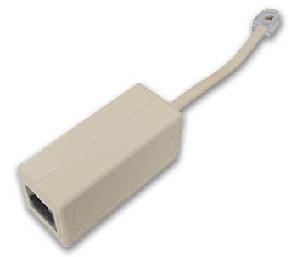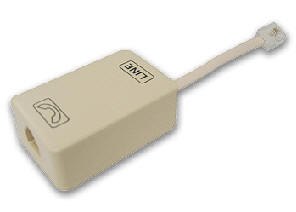Question: What is
the latest version of Personal Logger?
Answer:
The current shipping version is 3.3.18.0 - released 1/27/2014. (Requires Windows 2000©,
Windows XP©
and
DirectX 9.0c or newer, Windows Vista©,
Windows 7/8/10, Server
2003, Server 2008, Server 2012) Contact Tech
Support if you need an updated or alternate version.
Question: Is
Personal Logger Windows 64-bit Compatible?
Answer:
Yes.
Question: How so I connect a handset?
Answer:
A handset connection is most often used to connect to a digital PBX, VoIP phone, or multi-line analog phone.Handset plugs are smaller than outside line plugs, so a special cable and Y adapter are provided. Use them to connect from the handset to the recording module. Connect the USB cable to any available USB port on your PC

Question: The
calls are too loud / quiet. How can I change the volume?
Answer: The
microphone usually can be adjusted from within the preferences menu. however,
the preferred method is listed below:
Set the Start Level. Be sure that it does
not record when the phone is not in use. About here is standard.
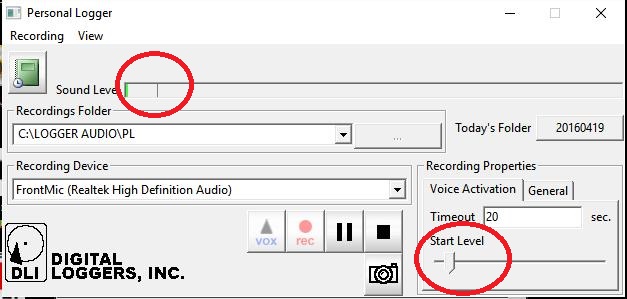
Verify the recording device in the Personal Logger.
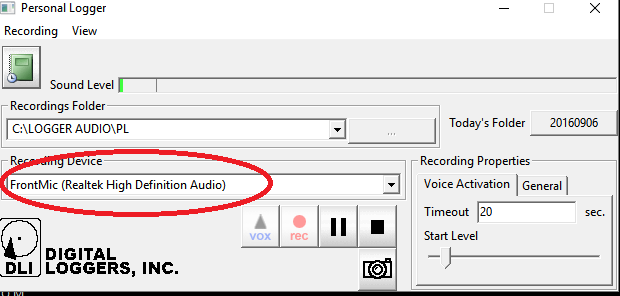
It should be the AK5371 if it is the USB logger.
.png)
Check the volume level. Keep the Personal Logger visible so that you can watch the volume.
Right-click on the speaker in the system tray and select the system tray and select "Sounds".
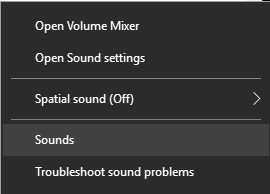
Select the recording tab.
*Alternatively, press the Start button, type "mmsys.cpl"
in the search box, then select the Recording tab.
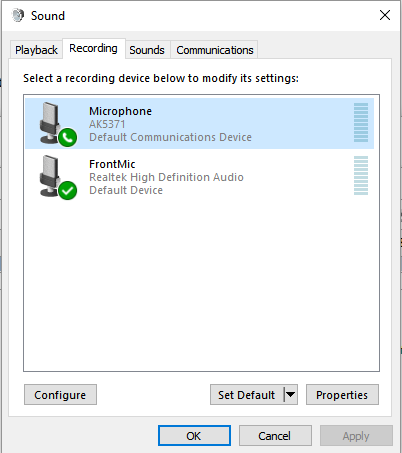
Select the Recording Device that the Personal Logger is using and choose Properties.
Select the Levels tab.
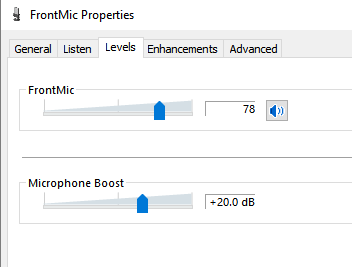
Move the level to the while talking into the phone and watching the
VU meter.
You should see the level only occasionally hit the end. You can
look in the Instant Replay window to see the wave form. You don't
want the flat ends to be too numerous. This will indicate clipping
and can cause distortion.
Too Loud:
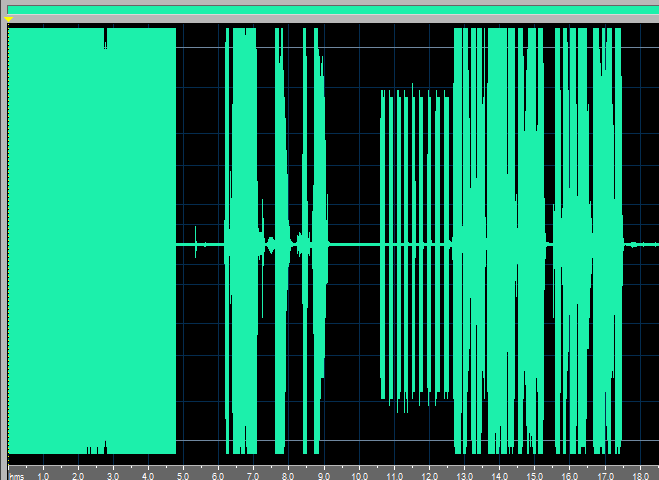
A good level
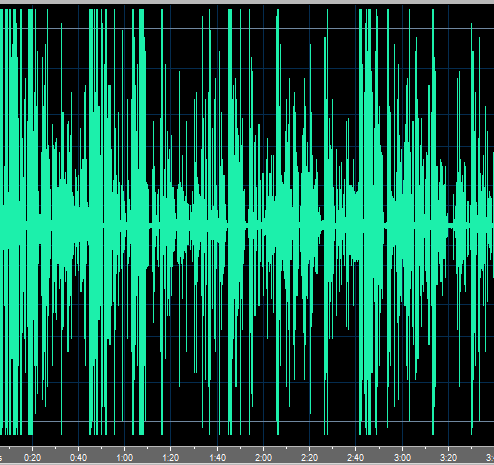
Question: There’s
no audio – Help!?
Answer:
Try one of these three
common solutions!
1. First, check your microphone
input level controls. If it's the USB Personal Logger, the microphone will
be the AK5371 device.
Adjust the device properties using
the Windows audio control panel. Be careful – there are two screens,
one for recording properties and one for playback properties. Switch between
them by using the “view” menu.
Each version of Windows has a slightly different way of checking and changing
the Recording Properties.
2. After you're
sure your microphone input is working, check the cables, and make sure that you are using the proper “Y”
connector and cable. The different types of connectors are described below.
3. Third, make sure the output
of the logger module is connected to the “MIC” jack on your PC,
not to the “LINE IN” jack.
Question:
What are the different connectors for?
Answer:
We want you to have everything you’ll need. There are two types of connectors.
One is a larger jack, called an RJ-11 jack which is used to connect to outside
lines. Look carefully and you’ll see a second type of jack which is slightly
smaller. The small “Y” connector and cable jack are used for connecting
phone handsets. If you've accidentally used the small connector on an
RJ-11
wall jack, you may have an unreliable connection, or no connection at all.
If the connector looks loose, switch to the larger plug.
Question:
How can I eliminate stuttering in the recordings?
Answer: Try starting/
stoping the recording, then test the next recording.
Question:
I sound louder
than the caller. Why?
Answer: This is a normal
effect when recording from an outside phone line. Your telephone includes
a device called a “hybrid duplexer” that makes your voice louder
to compensate for the loss of signal in the lines going to the phone company.
You can minimize this effect by checking “normalize recorded files”
under the “general” tab in the properties box. You can also eliminate
most of this effect by switching to a handset connection. Note that you won’t
receive caller ID information if you record from a handset.
Question:
What's the hidden mode? How does it work? What are the
legal implications?
Answer:
If you selected the 'Hidden' mode
installation when setting up Personal Logger, there are three things you should
be aware of:
1) Hidden mode applications must
operate in VOX mode. The application will not record continuously when hidden.
2) You may need to access the application
to change settings. To do so, press the key combination CTRL-ALT-HOME (all keys
simultaneously) and the application will appear. To make the application disappear
again, select 'Recording|Exit' or press the 'X' button in the upper right corner
of the window. A message box will appear. To stop the application completely,
press the 'Exit the Application' button. To hide the application again, press
the 'Re-hide the Application' button. To return to the application, press the
'Return to the Application' button.
3) Hidden mode is provided to reduce the clutter on your Windows desktop.
All recording laws must be observed, and this feature is not intended and should
not be used surreptitiously. Read more about recording
laws here.
Question:
How do the recording controls work? What do the buttons do?
Answer: Here's
a summary of the controls on the main Personal Logger screen. Press F1 for
more detailed help when running the application.
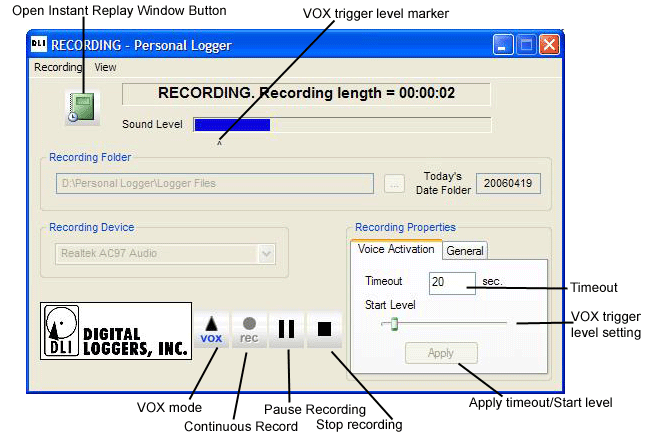
Question: How do
the playback controls work? What do the buttons do?
Answer: Here's
a summary of the controls on the main Personal Logger screen. Press F1 for more detailed help
when running the application.
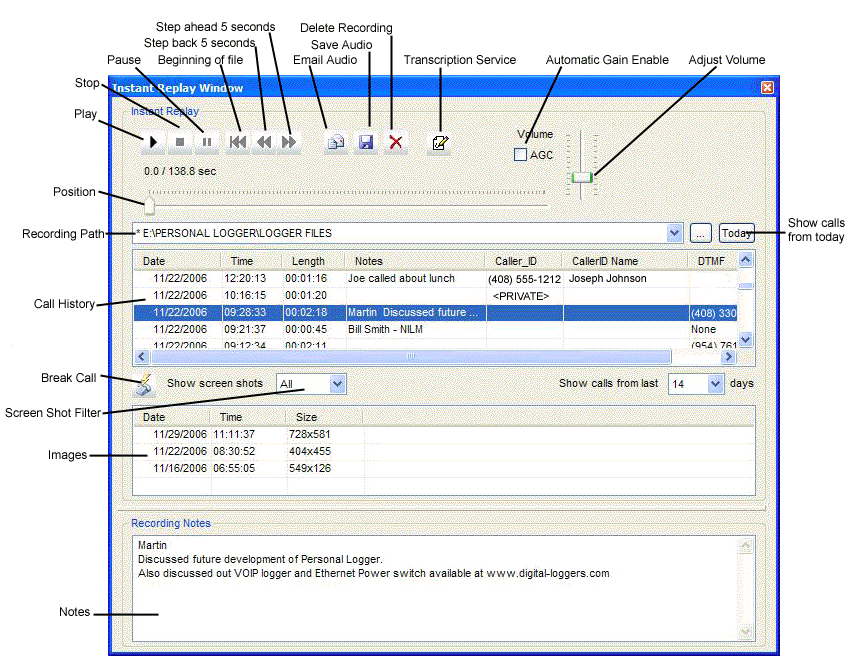
| Play Button |
Starts playing the selected call |
| Stop Button |
Stops playing a playing call |
| Pause Button |
Pauses a playing call |
| Jump to Start
Button |
Jumps to the start of a playing
call |
| Jump Back 5 Seconds
Button |
Jumps backward 5 seconds in the
playing call |
|
Jump Forward 5 Seconds Button |
Jumps forward 5 seconds
in the playing call |
|
Email WAV File Button |
Allows you to email
the selected call |
|
Save WAV File Button |
Save the selected
call as a WAV file |
|
Delete Button |
Deletes the selected
call (or press DEL key, or select from context menu) |
|
Output Device Selector |
Select the sound
card you wish to play calls to. This appears only if you have more than one audio output device
installed.. |
Question: How can
I find and play calls?
Answer:
Select View from the toolbar of the Personal Logger Application
and click on Show the Instant Replay Window. By selecting one of the headers, your recordings can be
sorted by date, time and length of call as well as by any Notes you've made for the recording.
Question: How can
I include recordings in a document?
Answer: Using Microsoft Word, choose the “Insert
-> File" option and use the browse button to locate the file you want in the correct date folder
and by time-stamped file name.
Question:
Why don't my recordings
go through e-mail?
Answer: There may be a message
size limit on your e-mail box, or on the recipient’s e-mail box. Here
are two workarounds:
1. Send shorter recordings.
Use the start/stop buttons to break long calls up into shorter segments.
2. Upload the file to a file repository such as Google Driv e or Drop Box and
send a link.
Question:
When is it legal
to record?
Answer: There’s no
short answer here. Federal laws require that at least one party being recorded
consent to the recording. Some states (such as California) require that both
parties consent. Consent is implied when a caller stays on the line after hearing
an announcement or statement such as “Your call may be recorded for quality
assurance”. Consent is not required where there is “no legal expectation
of privacy”, such as when calling 911. Businesses must post warning signs
when recording from microphones in some states. Additional federal regulations
apply to recordings made from radio receivers and to facsimile recording. We’re
not lawyers, and these laws change all the time, so check your local regulations
before recording. Hyperlink to our favorite web site with
recording laws: "Can We Tape?"
Question: The recording
level is low. How can I adjust it?
Answer: Make sure the output of
the logger module is connected to the “MIC” jack on your PC, not
to the “LINE IN” jack. Check the levels in the Windows Audio Control
Panel.
First, select "recording properties"
in the "view" menu.
Make sure the "select" box is checked under the microphone level control
bar in the recording controls. Make sure the slider bar is raised up.
Next, select "playback properties".
Check the "mute"
box under the microphone level control bar to prevent feedback. This will
prevent the audio from being played on the speaker while it is being recorded.
Question:
What is CID? What is ANI? How can I record Caller-ID?
Answer: CID
stands for Caller Identification.
It is also known as "Automatic Number Identification", or ANI. All DLI loggers
will record caller ID when connected to an outside line which has this service.
First, contact your local phone company and ask them to provide caller ID service
on the line you are recording.
Question: What
is ALI? How can I record ALI?
Answer:
ALI stands for Automatic Location Identification. ALI is transmitted to
911 call centers and emergency service dispatchers. Local telephone
companies keep a database which cross references telephone numbers to physical
addresses. These addresses include pay phones and numbers unpublished in
public directories. This data is normally provided using Bell-103 FSK at
300 Baud or 1200 Baud FSK in a format similar to CID. The local phone
company normally provides a modem and a terminal (or PC) to review this data
stream at the dispatch site. To keep a log of this data, an additional
serial port connection may be made to the network logger.
Question:
How can I create a .WAV file? How can I email a call? How can I
delete a recording?
Answer:
Simple. First, open the instant playback window. Select a completed
call by highlighting it with the mouse. Three buttons above the call list
will become active. Use the first one to email the call as a .WAV file,
the second to save a .WAV file, and the third to delete a call.
Question:
How can I adjust the voice activation (VOX) operation? How does the
logger start and stop recordings?
Answer:
VOX is synonymous with Voice Activated Switch. The Voice Activated
Switch in the Personal Logger controls the start and stop process which
separates calls into individual files. There are three settings which
affect the VOX operation in the Personal Logger program. These are found
in the lower right corner of the main Personal Logger window. The first is a
starting control called the sensitivity. Adjust the sensitivity by
clicking first on the Voice Activation tab under recording properties.
Moving this slider bar will adjust the sensitivity up or down and move an
arrowhead ^ under the VU meter. When the meter reaches the arrowhead,
recording will start automatically. Adjust the arrowhead so it is just to the
right of the meter level when the phone is on-hook.
If you experience "false
starts" and see files with clicks and pops in them, there is a second
adjustment. To reduce false starts, you can adjust a second
setting called the "transient noise length". This setting adjusts the
amount of time which must elapse with the recording level above the occur before
the recording starts. Increase the "transient noise length" to eliminate
small recordings with clicks and pops.
There's a third setting
called the timeout which controls the amount of silence that must be detected
before the recording file is closed and another file is started. The
exact adjustment is a matter of personal preference. Most customers
find that between 20 and 30 seconds for phone calls (10-20 seconds for radio
calls) works well.
Back To Top
Question: What is
a u-law (pronounced "mew-law") file?
Answer: u-law
is a non-linear coding system used by the telephone company to transmit audio in a digital format.
u-law operates at 8,000 samples per second in an 8-bit format. Because this is a logarithmic
format, it is more efficient than linear coding formats, such as the popular .WAV format. u-law
encoding is technically not a form "compression". Rather, it is a way of adjusting
the sampling characteristics of the Analog-to-Digital conversion process to match the logarithmic sensitivity
of the human ear. u-law encoding is typically referred to as "companding".
When an 8 bit u-law sample is sent, one bit is used to give the polarity of the signal (1 for positive,
0 for negative). The remaining 7 bits correspond to the logarithmic quantization of the sample.
An 8-bit u-law file offers performance equivalent to a 14 bit linear file. The less efficient
.WAV file format is the most common audio format used in transferring audio between PCs.
Question: What editing
software do you recommend for u-law files?
Answer: Sony Sound Forge is
one of the many programs that can be used for editing .au files.
Question:
What is "instant replay" or "real-time playback"?
How can I do this? What causes delays in playback?
Answer: These
terms refer to the playback of an audio file while it is being recorded. In most applications,
minimizing the time between recording and playback is desirable. Personal
Logger can playback recordings as they are being recorded.
Question: How do
I convert u-law files to .wav (Wave) format? How can I convert a u-law file to save it on a CD?
Answer: Creating
.wav files is easy. Note that the file will be larger in the .wav
format.
Using Personal Logger, just click on the file button to save in .wav
format.
Question:
What's a demark point?
Answer:
A "demark point" is a single point of entry into a building
for CO wiring. In most situations, the customer is responsible for all
wiring after the demark point, and the phone company is responsible for all
wiring before that point. A lightning arrestor is typically installed
by a phone company near the "demark point."
Question:
What's a CO
(Central Office)? Where does my phone line go?
Answer:
A central office is a local switching facility which routes voice
and data over telephone lines. It is typically located within the center
of a city. The phones in your home or office connect to a Central Office
and are routed from there through the worldwide Public Telephone Switching Network
(PTSN).
Question:
What's a handset jack? How do I connect a logger to it?
Answer:
A handset jack is a small 4 pin connector which carries the speaker
and microphone signals from your telephone to your handset. This is a
good place to connect an audio logger, since all your incoming conversations
may be recorded at this point. A typical signal level to the handset earpiece
is -20dBm, and this is adequate for most logging applications.
To connect to a handset, use the handset splitter supplied with your logger
and the small handset jacks. Pay careful attention as these jacks look
very similar to the RJ-11 and RJ-12 jacks described
below. Putting a handset plug into a larger RJ-11 or RJ-12 jack will result
in an unreliable connection.

Question:
What's an RJ-11 jack? How do I connect a logger to it?
Answer:
Most analog phone lines use an RJ-11 jack and plug in a single line
configuration. An RJ-11 jack has four wires and is called a 4P4C connector,
since it has 4 conductors in 4 places. Wires on an RJ-11 jack are colored
black, red, green, and yellow. The center pair (red and green wires) is
used to connect the ring and tip side of a single phone line. The yellow
and black wires are used for either a second line. The pinout for an RJ-11
jack is as follows:
Color Pin Signal
Black 1
AC Power or Tip (Line 2)
Red 2
Ring (Line 1)
Green 3 Tip (Line
1)
Yellow 4 AC Power
or Ring (Line 2)
The photo below shows a 6 pin RJ-12 jack on the
left, and a 4 pin RJ-11 jack on the right.
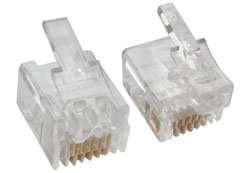
You'll find that a 6P6C crimp tool will work fine for both RJ-11 and
RJ-12 connectors. You'll need a different tool for handset connectors
and RJ-45s.
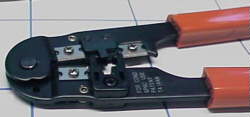
Question:
What's an RJ-12 jack? What's an RJ-14 jack? What wire colors connect
to each pin of the jack? How do I connect a logger to it?
Answer:
Most analog phone lines use an RJ-11 jack and plug in a single line
configuration, but there's a similar connector called an RJ-12 or RJ-14 which expands
the capacity of this jack to 6 pins. The 6P6C RJ-12/14 jack has the same
physical outline as an RJ-11 jack, but can contain 3 pairs of wires. An RJ-12/14
plug will fit into an RJ-11 jack and vice versa. If you insert a 4-pin
RJ-11 plug into a 6-pin RJ-12 jack, you will be connected to pins 2,3,4 and
5 of the RJ-12 jack. The "translation" of pin numbers when mismatching
jacks and connectors can lead to confusion.
DLI loggers use pins 1 and 6 of the RJ-12 to send power to remote
microphones. To wire an RJ-12 jack in a single line configuration, just
make sure the red and green pair is connected to pins 3 and 4 of the jack
for line 1, or pins 2 and 5 for line 2.
When two lines are connected to an RJ-12 or RJ-14, they should be wired as
follows:
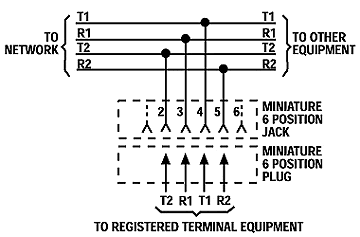
R1 and T1 are "ring and tip" for line 1. R2 and T2 are "ring and tip"
for line 2.
Jack
Positions |
USOC
RJ11 |
USOC
RJ12/14 |
|
| 2 |
|
wht/org |
|
| 3 |
blue/wht |
blue/wht |
|
| 4 |
wht/blue |
wht/blue |
|
| 5 |
|
org/wht |
|
Question:
What's an RJ-25 jack? How do I connect a logger to it?
Answer:
An RJ-25 jack is a standard 6-pin, 3-pair telephone jack. It's
wired as shown below:
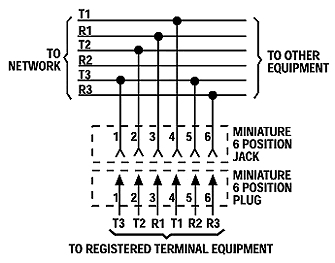
R1 and T1 are "ring and tip" for line 1. R2 and T2 are "ring and tip" for
line 2, and so on.

Jack
Positions |
USOC
RJ25 |
| 1 |
wht/grn |
| 2 |
wht/org |
| 3 |
blue/wht |
| 4 |
wht/blue |
| 5 |
org/wht |
| 6 |
grn/wht |
Question:
How can I inject a "record tone" or "warning tone" into
the handset of a phone being recorded?
Answer:
There are two ways to do this:
One is with a small logger
patch which connects externally to the handset connector. A typical unit
is the Dynametrix patch
Make sure you order the correct patch for your type of phone. Since there
are several types of microphones, (dynamic, electret condenser, and carbon),
there are several different patches available. Also, you may need an adapter
cable if you have a Sony or Panasonic phone system which does not use standard
handset wiring. External logger patches typically cost $100 per set.
To reduce the clutter on the desktop, there's a second, more expensive option.
Send your phone set in to a dealer, and they can install the record tone inside
the set. This is commonly done on Avaya station sets in telemarketing
applications. Plan on spending $150 to $200 per set if you choose this
option.
If you are connecting a logger to an outside analog line or to a port on the
PBX, you can inject the tone directly into the port or trunk, so you won't
need a logger patch.
Question:
How
can I adjust the VOX sensitivity on my 24 channel logger?
Answer:
The sensitivity is automatically adjusted using a noise-canceling VOX IC from
Motorola. If the input level is well over 0dBm, you may need to add a series
resistor to increase sensitivity and eliminate clipping. A 27K ohm resistor
will shave off about 5dBm.
Question:
How many recordings can I store on disk?
Answer: That depends on the length of each recording, and the sampling rate. Higher
sampling rates equate to higher sound quality, but use more disk space. Lower
sampling rates are called “compression”, and they sacrifice audio
quality in exchange for smaller files. Defense attorneys have argued that modifying
recordings using audio compression amounts to “tampering” with the
original recording. If you have the choice, record all lines in full fidelity.
All DLI loggers are capable of uncompressed recording on all channels simultaneously.
This allows you to keep a legal, full quality copy of each recording. If the
recording is not accessed, it can be automatically compressed to conserve disk
space. u-law recorded files take up about 1MB for each 2 minutes of recording.
That equates to 2,000 minutes (or about 33 hours) per gigabyte of disk space.
Question:
What is a Decibel? What is a dB?
Answer:
Telecommunications line levels are measured in decibels (dB). Decibels are a
power ratio measurement. Voltage, sound intensity, and electrical power may
be expressed in decibels. Telecommunications levels are typically expressed
as a ratio of power in either dBm or dBv. The most common measurement is the
dBm, which refers to a decibel level measured with respect to a one milliwatt
signal (typically on a 600 ohm line). Zero dBm is defined as a reference
level of one milliwatt of power into 600 ohms. A change of three decibels
is approximately double the power. A change of 60 decibels refers to a power
ratio of 1,000,000 to 1. Typical phone line levels are –3dBm peak for
bridging outside lines, and –13dBm for bridging handsets. DLI Loggers
will operate reliably with peak input levels in the range of –40dBm to
+3dBm. Higher levels need to be attenuated, and lower levels need to be amplified
prior to connection to the logger. A transmission impairment measurement (TIMS)
set or true RMS voltmeter with differential input is useful for checking input
levels prior to installation, and for troubleshooting logger connections.
Click to read more on how
decibels are used in measuring audio levels and to
brush up on what a logarithm is.
Question:
What is a Noise Floor?
Answer:
Phone line noise floors may range between –84dBm for a very quiet line
to –35dBm for a noisy line. Noise is typically worst on wet
lines when all phones are on-hook and the line is unterminated. Local telephone
companies have noise specifications based on the line distance to the central
office. Noise may be measured using a TIMS, and line
distance is measured using a time domain reflectometer (TDR). The VOX circuitry
in DLI network loggers automatically compensates for varying noise floors. Additional
circuitry in these loggers eliminates on-hook noise when wet
lines are detected. Noise floors can be significantly increased when analog
pairs are located near digital pairs. An example would be a long run handset
back-haul from a digital phone. If noise floors exceed acceptable levels, a
separate cable with a tighter wire twist should be considered. In the real world,
this translates into the use of CAT-5 or CAT-6 quality cables when lines are
run near transformers or fluorescent lights, or over long distances.
Question:
What is Line Impedance?
Answer:
Impedance is a measure of AC resistance. Lower resistances require higher currents
to achieve the same voltages. Telephone lines are terminated and matched to
their “characteristic impedance”. A “characteristic impedance”
is the most efficient way to transmit power through that particular type of
wire. Most phone lines are 600 Ohm impedance, although 135 and 120 ohm lines
are also common.
To achieve efficient transfer of
energy over a transmission line, the impedances of both the sending and receiving
equipment must be matched. If this is not done correctly, transmission
loss will occur.
The total impedance present on a phone line at a customer site is typically
900 ohms. All DLI loggers will directly connect to lines in this impedance
range, as well as to high impedance sources, such as handsets.
Question:
What is the impedance of a Headset or Handset?
Answer:
Most headset and handset impedances are in the range of 600 Ohm to 10K Ohm.
These connections may be directly bridged using a “Y” connector,
which ties to the logger. In call center applications, the connection to the
headset may be made inside the telephone itself, and the audio may be back-hauled
through an unused pair on the cable, or through a separate recording cable.
Question:
What is a "recording supervisory tone"? How can I inject this
into the line?
Answer:
This is a feature used to remind callers that they are being recorded.
It consists of a 1500Hz beep tone injected on the line at -6dBm for 500ms every
15 seconds. This recording tone feature is not provided
on our loggers. You'll need a third-party device to inject it.
If you're connected to a
handset, you won't be able to inject the tone through the earpiece. Recording
tones need to be injected through the microphone pins or through an outside
trunk. Products for microphone tone injection are available from
Dynametric.
Consider using a voice-mail system as a better way of informing callers that
they are being recorded. Using a PBX, a separate hunt group can be established
to announce "Your call may be monitored and recorded for quality assurance
purposes...".
Question: How
can I connect a Motorola radio to my logger?
Answer: RJ-45 connectors are common on Motorola. The exact connector and pinout depends on your radio
model. For information on
Motorola pinouts, click here.
Question:
What is the impedance of a Radio output?
Answer:
Most radio audio sources intended for connection to speakers are very low impedance
(typically 4 to 8 ohms). If you are connecting to a radio receiver output that
is intended for a speaker, bridge the line directly at the speaker connection.
If you choose to disconnect the speaker, a load resistor placed across the line
may be necessary for the radio amplifier to function properly.
In an E-911 application, the console will typically have a recording
output which is a 600 ohm balanced line.
If the output level at the
bridging point is over +3dBm, you should add a series resistor to bring it within
the logger’s input range of -40 to +3dBm. An example of a high level audio
source is a 70-volt public address speaker system. Connecting a 470K ohm resistor
in series with a 70-volt system will bring levels within the recording range
of the logger. A transformer may also help to match impedance if the logger
is located a long distance from the radios.
Keep in mind that the input
impedance of the logger is over 10K ohm. The logger is “AC
coupled”, and “DC Blocked” with capacitors at the input
stage, so you cannot measure the logger impedance directly with a DC meter.
Question:
What is a Wet Line? How can I tell if I have a Wet line?
Answer:
Wet lines are phone lines that draw power from the central office, or from a
PBX. Audio is superimposed upon the DC power. Power to the station set is direct
current (DC), and is typically 48 volts. To determine if you have a wet line,
you can connect a DC voltmeter across the line. A typical voltage range for
a 48-volt wet line in on-hook state is 44-50VDC. A typical voltage range for
a 48-volt wet line in the off-hook state is 5-15VDC when measured across the
equipment seizing the line. The MIL-4000N may be connected directly to
either wet or dry lines due to the DC blocking within the logger.
Question:
What is “On Hook Noise”?
Answer:
On Hook Noise is the noise present on a telephone communications line when
the phone is not in use. The MIL-4000N includes circuitry designed to eliminate
on-hook noise on 48-volt wet lines. This minimizes
noise input to the VOX circuitry. Line voltages over 41VDC cause the logger
to reduce input sensitivity, minimizing false VOX trips when the line is on
hook. An additional circuit will detect rings, start recording, and allow caller-ID
to pass to the recording. This on-hook control feature is automatically disabled
when the logger is connected to a dry line.
Question:
What is a “Loop Start Line”?
How can I tell if I have a loop start line? How do I connect a loop start controller?
Answer:
Loop start lines are phone lines which use a loop current to control on-hook
or off-hook conditions. Your home phone line is probably a wet
loop start line. To determine if you have a loop-start line,
you can call the phone company, check the tag at the demark point, or use a
meter to check the line. Loop start lines can also carry signaling
information when the phone is on-hook. A common example is a CENTREX
line with COV signaling. To log the audio only (and avoid recording the
signaling).
A loop start controller
is a unit which disconnects the phone line from the recording equipment when
the customer equipment is not in use (on-hook). It does this by sensing the
line current on the loop-start line. A current between 8 and 80 milliamperes
indicates an active loop.
To install a loop start
controller, you'll need to make three connections. The first two go to
the outside line (CO), and to the customer equipment (CPE). The controller
will monitor the current between these two connections and activate the third
port only when the customer equipment goes off-hook. Connect the third
port to your logging device and you're done.
Question:
What is a “Wink Start Line"? How can I tell if I have one?
Answer: Not
to be confused with loop-start, wink start signaling is commonly used on DID
lines. On a wink start line, the CPE or PBX first seizes the line by going
off-hook. Before connecting the call, the CPE waits for an acknowledgement
from the other end. The acknowledgement is a reverse of line polarity
(off hook) for a duration of 140 to 290ms. This is called a "wink".
The wink serves as an integrity check and can be used to identify a malfunctioning
trunk. If the CPE detects a malfunctioning trunk, it may switch to another
line. Just use a voltmeter connected across the line to tell if you have
a wink-start line. You'll notice the polarity reversal when the line is
picked up (seized). If you're using a "butt-set", the red and green
LEDs will flash alternately when the line is seized.
Question:
What is an “Immediate Start Line"? How can I tell if I have
one?
Answer:
An immediate start line uses no line seizure handshaking. The originating
side (CPE or PBX) seizes the line by going off-hook, and just starts sending
digits without checking the line condition or waiting for a response.
You'll know you have an immediate start line if the CPE goes off-hook and dials
with no outside connection.
Question:
What is a "Wet Delay Dial Line"?
Answer:
In Delay Dial mode, the originating side (CPE or PBX) seizes the line and then
waits for 150 to 150ms. After that, it checks to see if the line is on-hook
(with normal battery voltage). If so, it will dial digits. If not,
it waits until the line goes to normal polarity and then dials. You can
determine if you have a wet delay dial line by watching the polarity LEDs on
a butt-set.
Question:
What is a “Ground Start Line"?
Answer:
Ground start lines are seized when the originating side briefly connects the
ring side of the line to earth ground. Ground start lines are used to
connect most pay phones. The most common use of loggers with ground start
is in correctional facilities which monitor inmate pay phones.
Question:
What is a “COV Line"? What
is Code Over Voice?
Answer:
COV stands for "Code Over Voice". COV signaling is used mainly
on older voicemail systems to aid in communication between the voicemail system
and a separate PBX. COV signaling uses high frequencies above the voice
band to send signaling data. These high frequencies are superimposed on
the audio signal and then filtered to separate them from the voice signal when
recording.
Question:
What is bandwidth? What is the audio voice band? What frequencies
are sent over a phone line?
Answer:
Telephones have a frequency response curve tailored to transmit audio between
300Hz and 3.5KHz. This is the spectral area in which most of the energy
is present in the human voice. Accordingly, most phone connections have
a bandwidth of approximately 3Khz. Most analog phone equipment has a 3dB
per octave roll past these frequencies.
Question:
What is a “Dry Line”?
Answer:
Dry lines are phone lines, which transmit audio, but not power. Dry lines measure
0VDC at all times when checked with a DC voltmeter. Dry lines may be connected
directly to the logger. To connect a dry line, first verify that it is within
the levels mentioned above, then bridge it directly to the logger input.
Dry lines do not require a loop start interface card or line voltage interface card. Connect dry lines directly to your DLI
logger.
Question:
What is a “Balanced Line”? What is an “Unbalanced Line”?
How can I connect to them?
Answer:
Balanced lines are lines use to cancel noise. In balanced phone lines, two wires
are twisted together so that each wire picks up the same amount of noise. At
the receiving end, the noise is subtracted, and the resulting output is the
sent audio, minus the noise. A balanced line becomes "unbalanced"
when unintentional leakage to ground occurs. Unbalancing a phone
line causes noise. This can be a result of poor insulation somewhere along
the line, or a bad connection. The problem is often worse in the winter,
when outside lines are wet and leakage to ground occurs along the line.
Audio is usually sent down
shorter unbalanced lines using Coaxial shielding. This shielding prevents electromagnetic
noise from affecting a single wire. The inputs to all DLI loggers are balanced
lines. These inputs may be connected directly to unbalanced (i.e. Coaxial) lines,
and the ground may be connected to either side of the logger input.
Question:
What is a “Capacitive Coupling”?
Answer: Capacitive
coupling refers to the type of circuitry used in DLI loggers to connect to an
outside line. This type of coupling draws no DC current from the phone
line, so there is absolutely no DC loading (no DC current flows through the
logger) when connected to wet lines.
Question:
What is a POTS line?
Answer:
POTs is a generic acronym for Plain Old Telephone System. POTS lines may
be wet lines or dry lines,
and may use a variety of signaling formats, such as
ground start or loop start. The
one thing all POTS lines have in common is that they are balanced
analog lines, typically with a 600 ohm impedance.
Question:
What is a “2 Wire” line?
Answer:
A two wire line uses a single pair of balanced
conductors to carry both the transmitted and received audio paths.
The most common "POTS" or Plain Old Telephone System lines are 2-wire
lines. Better audio quality and separation is achieved when using 4
wire lines. A hybrid can be used to convert from 2-wire to 4-wire
line configurations.
Question:
What is a “4 Wire” or “E&M” Line? How do I connect
to it?
Answer:
Four wire lines employ a separate path for both heard (ear) and spoken (mouth) audio. These lines are
also called E&M or Ear and Mouth lines. You can think of each line as a pair of
two wire lines, each going an opposite direction. An external transformer combiner (hybrid) is required
to convert a four-wire E&M system into a two-wire output for the logger. Four wire E&M lines
should not be confused with single-pair lines in which a four-wire cable is used, but only the center
pair carries audio.
Question:
What is a D/A Converter? How do I connect it?
Answer:
D/A stands for Digital-to-Analog. A D/A converter is installed between
digital lines (usually station sets) and an audio logger. D/A converters
work by converting the signal stream from a digital station set into the standard
analog format used in an audio logger. They are available in single and multi-channel
versions.
Since there is no "standard" for digital station set interconnects
and line formats, single channel D/A converters are usually best purchased from
the manufacturer of the PBX and station sets to which you are connecting.
Multi-channel D/A
converters are commonly available on PCI cards. These cards are sold by
Dialogic (now
Intel) and others. Another common type is built into the base of a
KT-66 punchdown block. Again, every
phone system has a different format, so there are hundreds of D/A converters
available. Make sure you are purchasing the right one for your PBX and
station sets.
Question:
What's a DSL line? How do I connect to
a logger to record the analog audio on a Digital Subscriber Line (DSL)?
What types of DSL lines are there and what's the difference? What do all
these acronyms mean?
Answer: DSL
stands for Digital Subscriber Line. DSL refers to a technology used by
the phone company to increase the amount of communications (data or audio) that
can be passed down a single pair of copper wires for short distances.
Getting more out of an existing phone wire is referred to "increasing copper
bandwidth" or "pair gain". By transferring data faster,
the existing (and expensive to replace) telephone infrastructure is able to
handle more call traffic. DSL increases the amount of data sent on an
analog pair by sending much more than the 64Kbps required for a single analog
line down the same copper pairs used by analog lines.
Some types of DSL lines
are "hybrid", and carry both digital and analog data simultaneously.
When
things are working perfectly, there should be no interference between the two
signals: digital data and analog voice. In
the real world, filtering is sometimes needed to prevent the digital subharmonics
from entering the analog channel.
While DSL is usually as fast or faster than a T1, it is not necessarily as
reliable. Phone companies try to counter this downside by offering refunds
and "service level agreements" for DSL lines.
Although it's somewhat beyond the scope of this logging FAQ, here's a quick
explanation of the various types of DSL lines.
Question: What
a "hybrid"? What is transmission
loss? What is a "duplexer"? How do I adjust it?
Answer: When a signal is sent down
a transmission line, it is received at a lower level than it was transmitted
at. This loss of signal is referred to as "transmission loss".
A hybrid or "duplexer" is used to compensate for the transmission
loss that occurs on a transmission line. The most common duplexer you'll
encounter is used on a 2-wire balanced analog line.
Back To Top

If we haven't answered
your questions here, please call (408) 330-5599 or send
us an email. We'll be glad to help.
This page copyright © Digital Loggers, Inc. 2001-2020. Trademarks
are property of their respective holders.
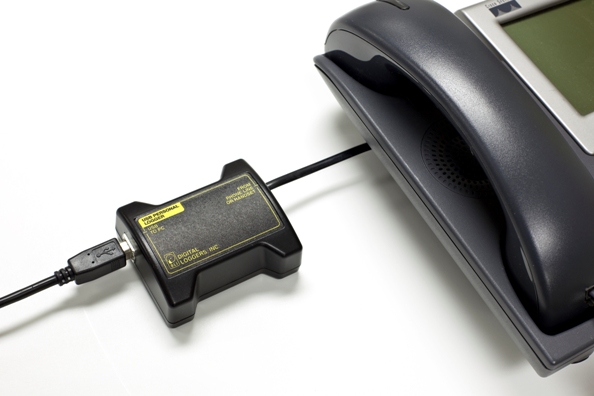



.png)







![]()





